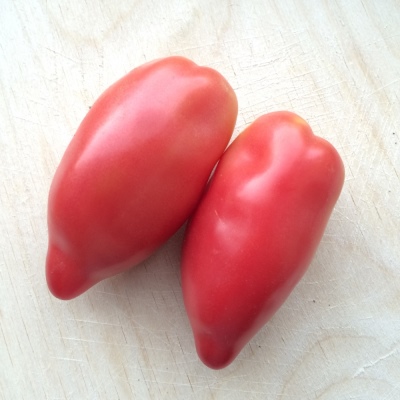
- Authors: Gavrish S.F., Kapustina R.N., Gladkov D.S., Volkov A.A., Semenova A.N., Artemyeva G.M., Filimonova Yu. A. (Scientific Research Institute of Breeding vegetable crops ", LLC" Selection firm Gavrish ")
- Year of approval: 2008
- Name synonyms: Kapia Pink
- Category: grade
- Growth type: indeterminate
- Appointment: fresh consumption, for pickling and preserving, for juice
- Ripening period: mid-season
- Ripening time, days: 117
- Growing conditions: for open ground, for film greenhouses
- Bush height, cm: 190-210
Tomato variety Kapia pink was approved for use in 2008. He has an indeterminate type of growth. The variety is also often referred to as Kapia Pink.
Description of the variety
Kapia pink is a tall species, the height of an adult bush can be from 190 to 210 cm. Leaves on plants are medium wide, long, with a dark green saturated color.
The main qualities of the fruit
Unripe tomatoes are green in color with a dark green spot near the stalk. The color of the ripe vegetable is pink. Each tomato weighs about 150 grams.
The shape of tomatoes of this variety is cylindrical, slightly ribbed. One cluster contains about 5-7 fruits. They all differ in their rather juicy and soft pulp.
Taste characteristics
The Kapia rose variety has excellent taste characteristics. It has a light sweet taste. Most often, ripe vegetables are used for fresh consumption, as well as for preservation and for making nutritious juices.
Ripening and fruiting
Variety Kapia pink is mid-season. The ripening period begins 117 days after planting. Harvesting can be done in July.
Yield
The crop is considered to be fruitful. From each bush, you can collect 4.5-5 kg of tomatoes, from 1 square meter of territory, about 9 kilograms of vegetables are collected.
The timing of planting seedlings and planting in the ground
Sowing should be done in February-March. Planting in a permanent place in open soil is carried out in May.

Growing tomato seedlings is an extremely important process, because it largely depends on whether the gardener will be able to harvest at all. All aspects must be taken into account, from seedbed preparation to planting in the ground.
Landing scheme
Planting of plants is carried out according to the scheme of 40x60 centimeters. The planting density should be 3-4 bushes per 1 square meter of land.

Growing and care
To form strong seedlings, you first need to prepare seed material, containers for planting and soil mixed with nutritious fertilizers (peat is most often used). Soil is poured into each plastic container. It must be slightly moisturized.
The seeds are laid out on top, deepening slightly under the ground. All this is lightly powdered and in this form is sent to a dry place at room temperature. Regularly it will be necessary to check the vegetation, to control that the earth is moist.
After the appearance of the first small leaves, the plants are planted already in open ground.Landing holes are pre-dug. Pour nutritious dressings into them. At the end, after planting, the land around the plants is well watered.
It should be remembered that this species needs good lighting, therefore, before the formation of planting holes, it is necessary to correctly determine the location. It should be sufficiently illuminated by the sun's rays and be reliably protected from the winds. The best predecessors of Kapia pink will be carrots, cauliflower, greens, cucumbers and zucchini.
This variety of tomatoes needs a garter and formation of bushes. Also, the land around the vegetation must be periodically loosened and weeded, there should be no weeds around them.
In addition, the plants must be watered abundantly periodically. During periods of heavy rain, the amount of watering should be reduced so that the soil does not become too waterlogged.
Bushes also need feeding. For the first time, you can use a ready-made composition with nitrogen. In the future, it is not worth using it, as this can negatively affect the fruiting process.
Vegetation should be fertilized primarily with mineral subcrust. Complex formulations with all the necessary trace elements would be a good option.




A plant needs different micronutrients at each stage of growth. All fertilizers can be divided into two groups: mineral and organic. Folk remedies are often used: iodine, yeast, bird droppings, eggshells.
It is important to observe the rate and period of feeding. This also applies to folk remedies and organic fertilizers.
Disease and pest resistance
Pink capia has a fairly high resistance to various diseases and harmful organisms due to strong pronounced immunity. But still, it is recommended to carry out preventive measures in order to accurately avoid the defeat of the culture. Sometimes a greenhouse whitefly can be seen on the bushes. In this case, the insects are removed by hand, and then treated with a folk remedy or fungicide.
As a preventive measure, you can use various ready-made preparations that have copper in their content. You also need to regularly inspect the crop and check it for harmful insects and affected areas.


Review overview
This tomato variety has received a lot of good reviews. Many gardeners have noticed that it has excellent germination, high yield, juicy and soft pulp.
In addition, it was said that ripe tomatoes boast excellent taste, they are often used for freezing and for canning, cooking salads. According to gardeners, the variety is distinguished by the most powerful and strong stems.

























































































